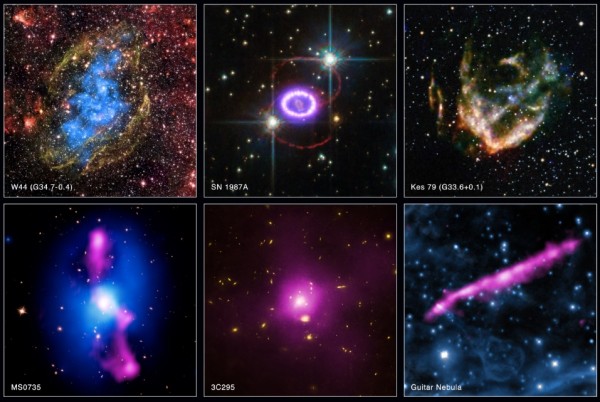By Ana Verayo, | May 08, 2016

W44: Also known as G34.7-0.4, W44 is an expanding supernova remnant that is interacting with dense interstellar material that surrounds it. X-rays from Chandra (blue) show that hot gas fills the shell of the supernova remnant as it moves outward. SN 1987A
Astronomers now believe that there are far more galaxies than previously thought with this new study, revealing how massive, glowing gas clouds formed by space dust are apparently strong evidence of several galaxies and not just a single star system, obscured from view.
Like Us on Facebook
This suggests that there are more galaxies in general, that can be observed from ground telescopes, along with the theory that each single galaxy is now producing less starlight than first believed, since several galaxies occupy a single massive, gas cloud.
Astronomers now utilized this new algorithm based on stellar data and statistics, allowing scientists to pinpoint which particular group of galaxies are lighting up certain clouds of hot gas in distant systems. However, there have been two major challenges that have been preventing astronomers in computing and determining the sources of illumination of these interstellar star dust that are scattered in the cosmos.
The first obstacle involves technical issues since infrared scans can only reach so far that are utilized by observatories today, including resolutions that are not yet powerful enough, that result in showing several different galaxies in one massive gas cloud, instead of pinpointing individual galaxies inside that hot cloud of glowing gases, obstructing the view from Earth.
The second obstacle involves data gathering and analysis, where scientists' current way of processing these images and data is by attributing the closest galaxy to the main source of gleaming light, therefore obscuring other galaxies from view.
In this new study, astronomers now use this new statistical algorithm to determine the other hidden galaxies from a massive gas cloud, by assigning a single galaxy as the main source of this starlight if it is at the center of this glowing blob of stellar light. This also suggests that several other galaxies are also irradiating that glowing gas cloud.
This new way in determining and analyzing how many galaxies are being obscured by cosmic glowing gas clouds can also provide new insight about how quickly stars are produced from galaxies.
According to lead author of the study, astrophysicist Jillian Scudder from the University of Sussex, this has been a truly interesting result since it has always been assumed that only a single galaxy illuminates from all these dust emissions in a glowing gas cloud, which now implies that a galaxy is now forming a tremendous amount of stars.
This new algorithm is detailed in the journal, Monthly Notices of the Royal Astronomical Society.
-
Use of Coronavirus Pandemic Drones Raises Privacy Concerns: Drones Spread Fear, Local Officials Say

-
Coronavirus Hampers The Delivery Of Lockheed Martin F-35 Stealth Fighters For 2020

-
Instagram Speeds Up Plans to Add Account Memorialization Feature Due to COVID-19 Deaths

-
NASA: Perseverance Plans to Bring 'Mars Rock' to Earth in 2031

-
600 Dead And 3,000 In The Hospital as Iranians Believed Drinking High-Concentrations of Alcohol Can Cure The Coronavirus

-
600 Dead And 3,000 In The Hospital as Iranians Believed Drinking High-Concentrations of Alcohol Can Cure The Coronavirus

-
COVID-19: Doctors, Nurses Use Virtual Reality to Learn New Skills in Treating Coronavirus Patients







